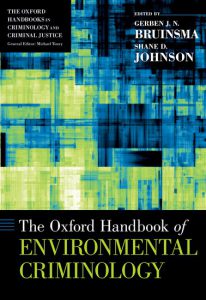The Oxford Handbook of Environmental Criminology

In crime it is not only important who violates the law and why, but also where and when. In which cities, neighborhoods and streets do we find the most victims? And in what season and at what time of the day do most of the offenses take place? Ever since the emergence of criminological science, research has been conducted into differences between countries, cities, locations and times in relation to crime.
Characteristics spatial environment
Much research has been done within this environmental criminology and many theories have been developed. These have in common that they are not about individual differences between perpetrators, but characteristics of the spatial environment. This may vary from the physical and social composition of residential areas to the amount of police on the street; and from the amount of people in the street to the characteristics of buildings.
Detailed and advanced research methods
In The Oxford Handbook of Environmental Criminology, international experts discuss developments in the field, theoretical issues, research methods and specific types of crime. The editors outline the history of the research area from the beginning of the 19th century. They show that the field is flourishing and has been using increasingly detailed and sophisticated research methods over the last twenty years.
How does a perpetrator choose his location?
The book covers inter alia the relationship between neighborhood characteristics and crime in the United States, Europe and Africa, characteristics of buildings and existing facilities, the role of street networks and supervisors, characteristics of specific locations, seasonal influences and different times, and the way perpetrators choose their locations. The book also deals with a number of specific types of crime, such as cyber crime, maritime piracy and terrorism.
Publication details and further reading
Bruinsma, G.J.N., Johnson, S.D. (2018). The Oxford Handbook of Environmental Criminology. In addition to the compilers, a number of (ex-)researchers from the NSCR participated in the book: Wim Bernasco, Evelien Hoeben, Danielle Reynald and Frank Weerman. For more information, see Oxford University Press.

Actuele berichten

